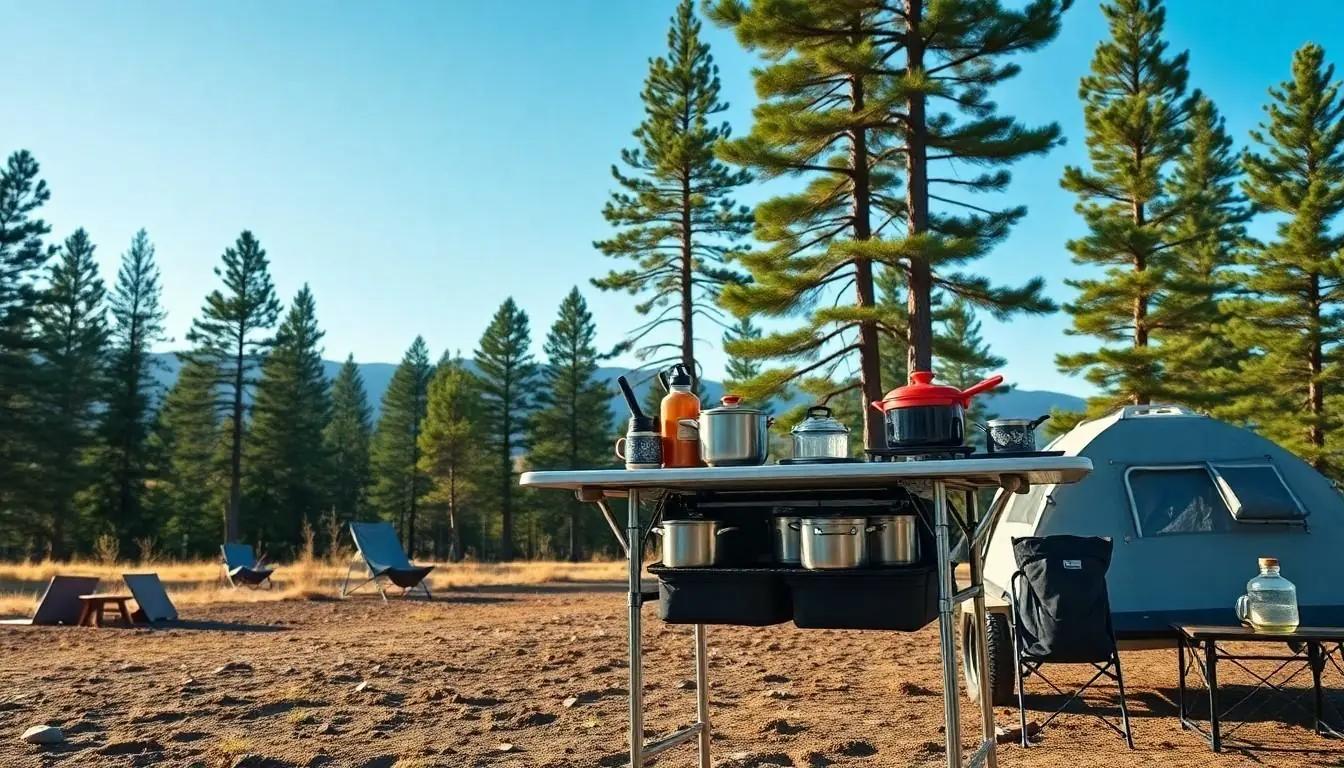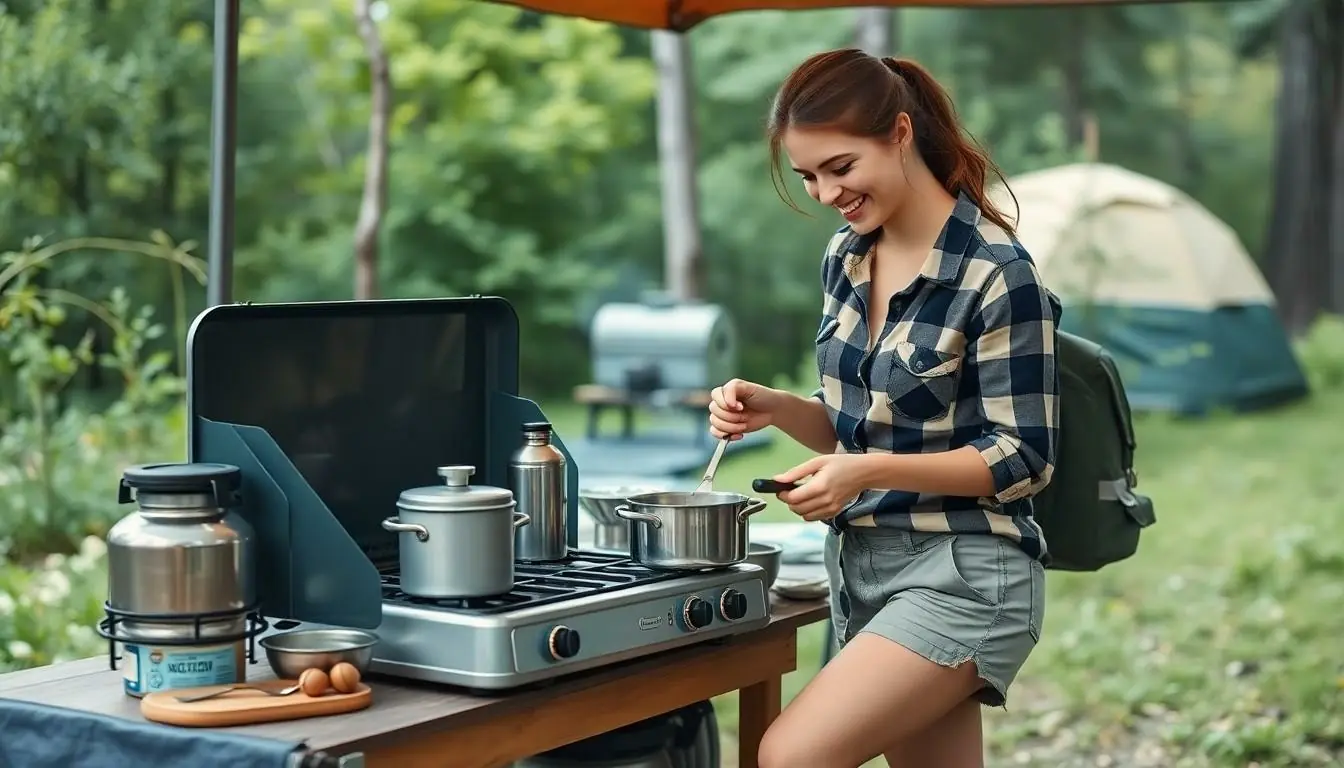Table of Contents
TogglePicture this: you’re surrounded by nature’s beauty, the crackling campfire is lighting up the night, and the smell of sizzling bacon wafts through the air. But wait—what’s that? A half-cooked meal teetering on a rickety folding table? Enter the camp kitchen, the unsung hero of outdoor adventures. It’s not just a place to whip up meals; it’s where culinary dreams meet the great outdoors.
A well-equipped camp kitchen can transform any camping trip from a culinary disaster to a gourmet getaway. With the right setup, you can impress your fellow campers with everything from hearty stews to gourmet s’mores. So why settle for instant noodles when you can elevate your camp cooking game? Let’s dive into the essentials that’ll make your camp kitchen the envy of every campsite.
Overview of Camp Kitchens
Camp kitchens serve as an essential element in outdoor cooking, significantly enhancing the camping experience. Essential gear includes portable stoves, cookware, utensils, and food storage containers. Campers can prepare diverse meals, transitioning from basic instant noodles to gourmet dishes with fresh ingredients.
Portable stoves offer convenience, allowing chefs to cook meals quickly and efficiently. Different types exist, including propane, butane, and wood-burning stoves, each catering to varying preferences and camping conditions. When selecting a stove, factors like fuel type and cooking capacity play a critical role.
Cookware options for camp kitchens range from lightweight pots and pans to cast-iron skillets. Each piece should be durable and suitable for different cooking methods, such as boiling, frying, or baking. Many campers prefer nesting cookware sets, which save space and simplify packing.
Utensils also form a vital part of camp kitchens. Essential tools include spatulas, knives, and tongs. Opting for multi-functional utensils can maximize efficiency and ease of use while cooking outdoors.
Food storage containers are crucial for keeping ingredients fresh and safe from wildlife. Various types, such as airtight bins and cooler bags, help maintain proper temperatures and protect items from contamination. Additionally, meal planning simplifies food preparation and minimizes waste during camping trips.
Comfort is another key aspect, as a well-organized camp kitchen fosters a pleasant cooking environment. Setting up a dedicated cooking area with tables, chairs, and shelters not only improves functionality but also enhances social interaction among campers. Prioritizing these elements creates a more enjoyable culinary experience in nature.
Types of Camp Kitchens

Camp kitchens can vary based on design and functionality, offering options tailored to different camping needs. Understanding these types helps campers choose the most suitable setup for their outdoor culinary adventures.
Portable Camp Kitchens
Portable camp kitchens provide flexibility for campers who enjoy cooking on the go. These kitchens typically feature compact designs, with foldable tables and integrated storage solutions. Utilizing lightweight materials, they can easily fit into vehicle trunks, allowing for convenient transportation. Many models come equipped with shelves for organizing cooking essentials. Their adaptability allows for setup in various outdoor locations, whether at a campsite or along a hiking route.
Stationary Camp Kitchens
Stationary camp kitchens offer a more permanent cooking solution for extended stays. These kitchens often include sturdier structures like tables and outdoor stoves. Campers benefit from enhanced organization with designated areas for food preparation and cooking. Some setups even incorporate built-in shelters to protect against adverse weather conditions. Stationary options allow for a comprehensive and comfortable cooking experience, making it easier to prepare elaborate meals in nature.
Essential Features of Camp Kitchens
Camp kitchens include key features that enhance outdoor cooking experiences. Essential elements focus on both cooking equipment and storage solutions.
Cooking Equipment
Portable stoves are vital for any camp kitchen setup. They come in propane, butane, or wood-burning varieties, allowing flexibility for different cooking styles. Lightweight cookware such as non-stick pots and durable cast-iron skillets are preferred for their versatility. Nesting pots conserve space, while multi-functional utensils like spatulas, knives, and tongs increase efficiency. Compact grills or griddles complement stove options, enabling a variety of meal preparations. Cooking thermometers ensure food safety, while durable cutting boards provide sturdy surfaces for meal prep.
Storage Solutions
Food storage containers play a critical role in maintaining ingredient freshness. Airtight bins prevent spoilage, while cooler bags effectively regulate temperatures for perishable items. Organizing supplies in designated containers reduces clutter, making cooking easier. Compact and stackable storage options allow campers to maximize space. Additionally, dry bags are useful for waterproof protection of food items during unexpected weather. Labeling containers simplifies ingredient access, which is especially helpful during larger group meals. Maintaining an orderly kitchen contributes to a more enjoyable outdoor cooking experience.
Benefits of Using Camp Kitchens
Camp kitchens enhance the outdoor cooking experience significantly. Convenience stands out as a primary advantage, allowing chefs to prepare meals effortlessly in the wilderness. Organization yields another benefit, helping campers keep cooking utensils and ingredients neatly arranged, thus minimizing clutter during meal prep.
Flexibility plays a critical role in the enjoyment of outdoor cooking. Portable camp kitchens adapt easily to various locations, enabling meals from different vantage points, whether by the lake or inside a cozy tent. Efficiency arises from having all necessary equipment in one compact area, reducing time spent searching for tools.
Safety also becomes paramount in well-equipped camp kitchens. Using proper food storage containers minimizes the risk of wildlife encounters and maintains food freshness. Additionally, portable stoves with specific fuel types ensure controlled cooking, reducing fire hazards commonly associated with open flames.
Creativity flourishes in a camp kitchen, too. Campers often find inspiration to create gourmet dishes with basic ingredients, transforming ordinary meals into memorable experiences. Cooking together fosters camaraderie, turning meal prep into a social event rather than a chore.
Comfort is crucial for a positive camping experience. Setting up a dedicated cooking area with tables, chairs, and shelters can alleviate strain and promote relaxation while preparing meals. Engaging in communal cooking not only reduces stress but also enhances the overall enjoyment of outdoor adventures.
Ultimately, camp kitchens optimize outdoor cooking, making meals more enjoyable, organized, and safe while encouraging creativity and social interaction.
Choosing the Right Camp Kitchen
Selecting the right camp kitchen plays a crucial role in outdoor cooking success. Campers should consider portability and storage features, ensuring the setup suits their specific needs. Portable camp kitchens offer flexibility, making them ideal for campers who appreciate cooking on the move. Those seeking a more stable option might prefer stationary setups, which provide sturdier structures and dedicated food preparation areas.
Cooking equipment demands careful thought. Comfort hinges on choosing the appropriate stove, with options like propane or butane stoves catering to different preferences and cooking capacities. Lightweight cookware simplifies transportation, while durable materials like cast iron withstand outdoor conditions. Multi-functional utensils streamline meal preparation, allowing campers to pack fewer items without sacrificing functionality.
Food storage also warrants attention. Airtight bins maintain ingredient freshness, helping avoid wildlife encounters while minimizing spoilage. Utilizing cooler bags aids in preserving perishable items during trips. Organizing supplies with stackable containers enhances accessibility, preventing clutter and ensuring a smooth cooking experience.
Budget considerations shouldn’t be overlooked. Evaluating the total investment in equipment and setup helps campers select options that provide the best value. Prioritizing essential features and quality over quantity leads to better long-term satisfaction with the camp kitchen.
Lastly, personal preferences impact choices. Some campers enjoy communal cooking while others prefer more solitary meal prep. Understanding these individual dynamics helps determine the ideal camp kitchen setup, ensuring an enjoyable outdoor culinary adventure.
Camp kitchens are more than just a convenience; they elevate the entire camping experience. By investing in the right equipment and organization, campers can enjoy delicious meals that bring people together in the great outdoors. The ability to cook creatively while ensuring safety and comfort makes every outdoor adventure memorable.
Whether opting for a portable setup or a stationary one, the choices available allow for personalization based on individual needs and preferences. Embracing the art of outdoor cooking not only enhances meal quality but also fosters a sense of community among campers. With the right tools and mindset, anyone can transform their camp kitchen into a hub of culinary delight and shared experiences.



